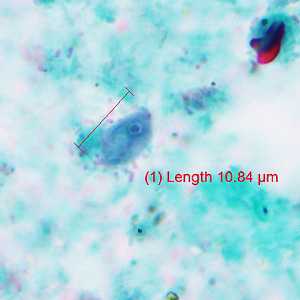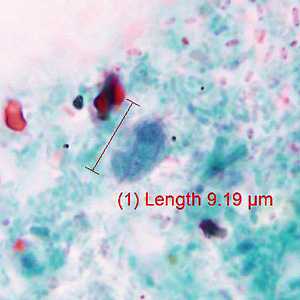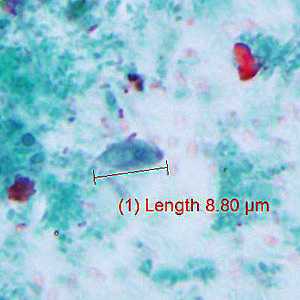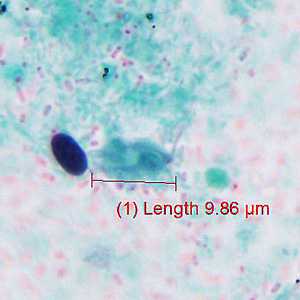
Case #429 - October, 2016
A stool specimen was collected from a 76-year-old man as part of a visit to his health care provider. The stool was collected in a single-vial preservative for ova-and-parasite testing. This allowed for concentration and trichrome staining to be performed at the Iowa State Hygienic Laboratory. The result of the concentration was No Observed Parasites (NOP) with rare white blood cells noted. Possible parasites were observed on a fecal smear stained with trichrome and images were captured (Figures A-D) and sent to the CDC DPDx Team for laboratory assistance. What is your diagnosis? Based on what criteria?

Figure A

Figure B

Figure C

Figure D
Case Answer
This case showed the nonpathogenic flagellate, Pentatrichomonas hominis. Diagnostic features shown included:
- trophozoites within the size range for P. hominis (6-20 micrometers long).
- trophozoites containing a single nucleus and a posteriorly-directed axostyle.
- presence of flagella; although P. hominis has five flagella, few, if any, are generally seen on stained smears.
More on: Pentatrichomona hominis
This case and images were kindly provided by the Iowa State Hygienic Laboratory Coralville, IA.
Images presented in the monthly case studies are from specimens submitted for diagnosis or archiving. On rare occasions, clinical histories given may be partly fictitious.
DPDx is an education resource designed for health professionals and laboratory scientists. For an overview including prevention and control visit www.cdc.gov/parasites/.
- Page last reviewed: December 8, 2016
- Page last updated: December 8, 2016
- Content source:
- Global Health – Division of Parasitic Diseases and Malaria
- Notice: Linking to a non-federal site does not constitute an endorsement by HHS, CDC or any of its employees of the sponsors or the information and products presented on the site.
- Maintained By:


 ShareCompartir
ShareCompartir